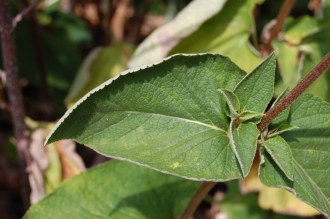Position: Full sun to dappled shade
Flowering period: Summer
Soil: Moist, well drained
Eventual Height: 1m
Eventual Spread: 1m
Hardiness: 7a, 7b, 8a, 8b, 9a, 9b, 10a, 10b
Family: Lamiaceae
Phlomis samia is a small evergreen herbaceous perennial with a clump forming habit. Its grey green leaves are cordate, up to 12cm long, aromatic and the undersides are covered with fine hairs. Its pink flowers are up to 3cm long, hooded and appear in whorls in the upper leaf axils in clusters on upright stems. Its fruit is a four to three sided nutlet.
Phlomis samia, commonly known as the Greek Jerusalem Sage, is native to south east Europe and south west Asia. In it native habitat it grows in Pine and Cedar forests.
The etymological root of the binomial name Phlomis is from the Greek word for mullein (Verbascum), due to the similarity of the leaves. Samia named after the Greek island Samos.
The landscape architect may find Phlomis samia useful as a low maintenance perennial suitable for dryer soils. Once established this plant is drought tolerant. It is unappealing to deer or rabbits.
Ecologically, Phlomis samia flowers are attractive to nectar loving insects. The larvae of some moths and butterflies find its foliage appealing.
Phlomis samia prefers moist, fertile, well-drained soils. It tolerates most pH of soil.
Phlomis samia requires little maintenance. Stems may be cut to ground level to promote a tidy appearance.







Leave a comment